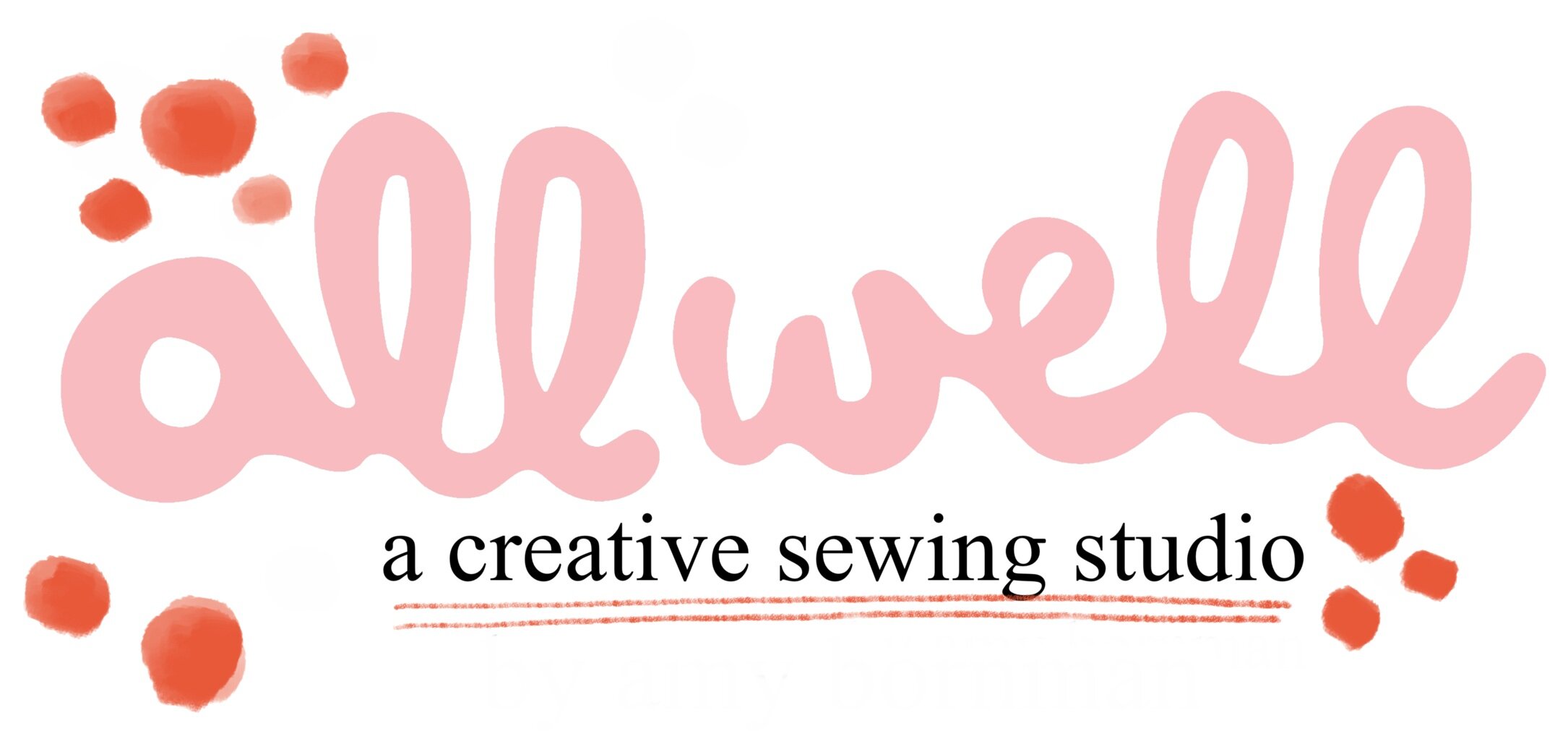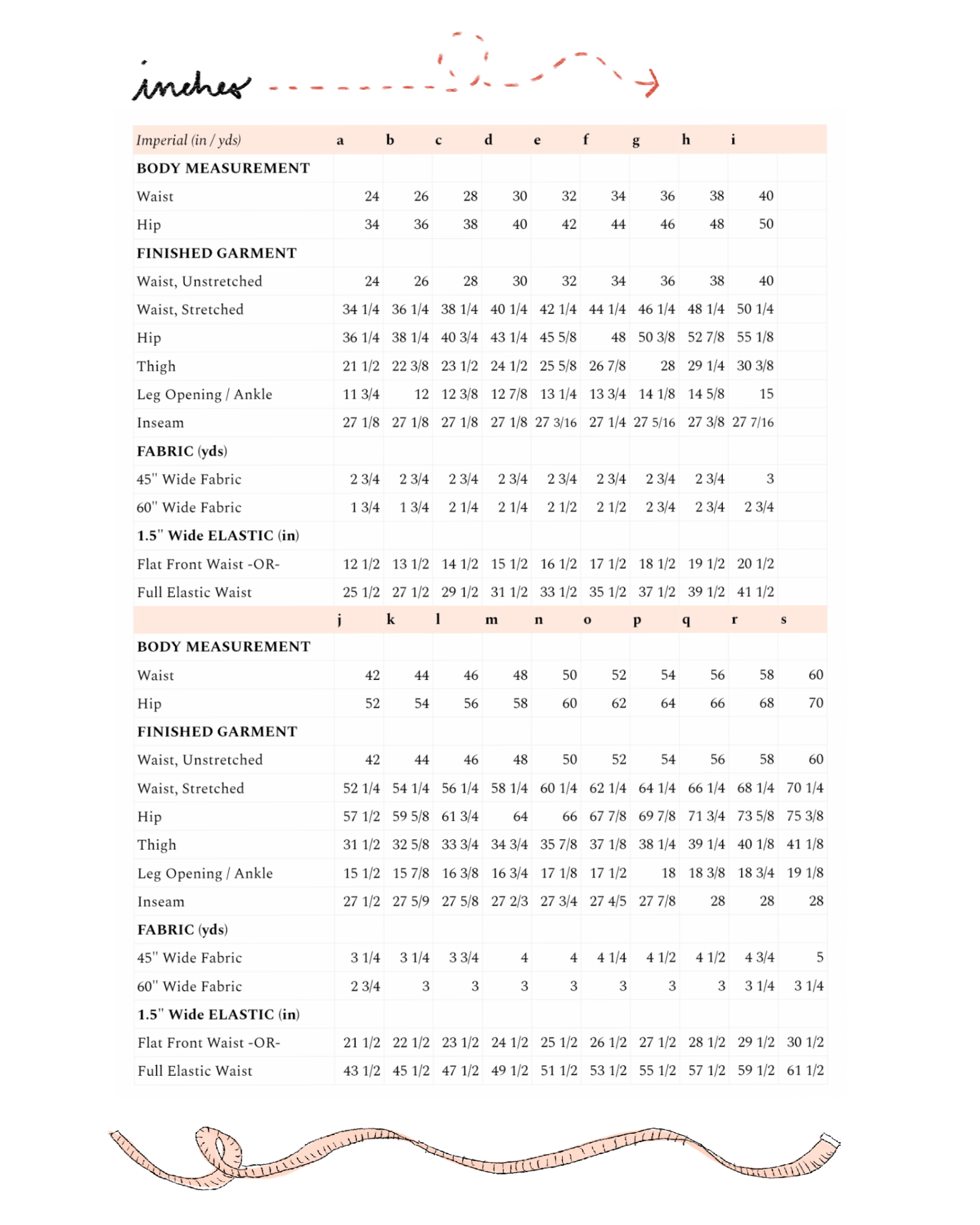All Well Studio Pants! Fabric and Notions
To figure out how much fabric and elastic to buy, take a first pass at figuring out what size you will sew using the sizing and measurement chart. The obvious (or not-so-obvious) secret of size charts is that they are by nature quite arbitrary. You’ll likely find that your measurements don’t fit you perfectly into one particular size. Likewise, the way we like our clothes to fit is extremely personal! Every garment is designed and fitted for a certain amount of wearing ease, but ultimately the way you wear that ease has everything to do with your own personal style and comfort. Use the size chart and garment measurements as a jumping-off-point – and we’ll help you find your way to pants that really work for you in the instructions booklet.
Waist — measure around the point where your body naturally hinges when you bend side to side – usually a bit above the belly button. You’ll use this measurement to choose the length of your elastic.
Hip — measure around the widest part of your hips and butt. If you’re not used to taking sewing measurements, it might be a bit lower down than you expect. Make sure the tape is level with the floor all around. Because the Studio Pants have an elastic waist, this measurement is the most important one for choosing your size. (Since you’ll want the pants to fit well over your hips as you pull them up!)
Add fabric length if you want to lengthen the inseam — the pattern is drafted to be cuffed once at the ankle for someone who is 5’3” (160 cm). You’ll need about twice as much extra length of fabric as what you want to add to the inseam. For example, someone who is 6’ tall (183 cm) and wants to lengthen the inseam by about 4” (10.2 cm), would need twice that extra length, about an extra quarter yard/meter.
Fabric for making a muslin!
Besides the fabric for the pants you’ll actually wear, you’ll need fabric for making a muslin! This is a test pair of pants that you’ll sew, seam rip, check and adjust the fit, and maybe mark directly on. To sew your muslin, you’ll need a similar amount of fabric as indicated in the chart (just with no pockets!).
We like to use inexpensive fabric that we’re not super attached to – well worn bed sheets, curtains, tablecloths or similar fabric is one of our favorite ways to source muslin material. Maybe you or someone you know has an old sheet in need of retirement, or you could find one at a thrift store, creative re-use store, or a Buy Nothing group? It’s also possible to make a “wearable muslin” using the fabric you intend to use for your finished pants! Muslins don’t have to be made in throw-away fabric! It’s totally up to you!
What types of fabric are good for the Studio Pants?
The Studio Pants feel great in a non-stretch woven bottomweight fabric with some drape, ideally anywhere from about 5-10 oz (170 - 340 gsm) in weight. Some examples of what would work really well are heavy linen, linen-cotton blends, cotton twill, denim, corduroy, and washed cotton canvas, or other similar fabrics. Use the charts above to find how much fabric is recommended.
These pants work well in a variety of fabrics. Amy has sewn her pairs in denim, canvas, linen, corduroy and a few other fabrics. The Studio Pants feel different depending on what you choose — a good way to use the same pattern several times and end up with a variety of pants to wear!
Notions
The Standard Necessities: Sewing machine, Steam Iron, Ironing Board, Pins, Safety Pins.
Thread (all-purpose works great!)
1.5” (3.8 cm) wide elastic, at least as much length as shown in the Measurements Chart, based on your waist measurement. Elastic lengths are different for the Flat Front and the Full Elastic Waist variations. Elastics vary a lot; if you’re buying off of a bulk spool, you might want a couple extra inches/centimeters. Don’t cut it to length until you sew.
Removable Marking Tool, like tailor’s chalk, wax paper and a tracing wheel, or similar.
TIP! We really like Dritz Non-Rolling Elastic – it’s really good at doing what it says it will do (not rolling!) and it’s high quality with great stretch retention. All elastics aren’t made equally, so if you don’t go for this brand specifically, try to source one that’s non-rolling and well made! It will make your pants more enjoyable to wear for a long time.
That’s it! Once you have your fabric and notions, you’re ready to make some studio pants. PANTS!!





